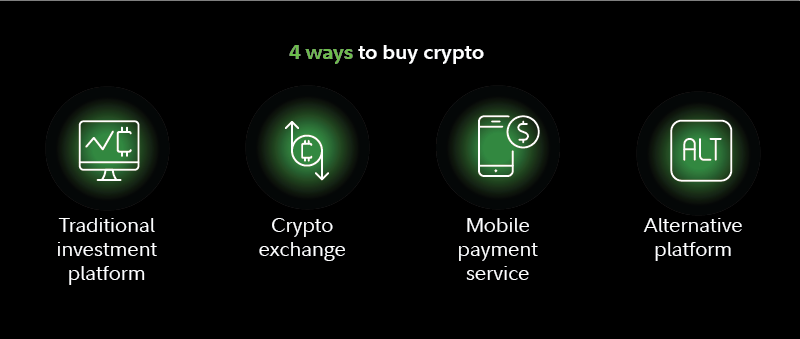Key Takeaways
- Cryptocurrencies can be bought on traditional investment platforms, crypto exchanges, select mobile payment services, and alternative platforms.
- Cryptocurrency is highly volatile and may be more susceptible to market manipulation than securities.
- Crypto investments are not insured by the FDIC or SIPC, and the future regulatory environment for crypto remains uncertain.
You’ve learned what cryptocurrency is, how it works, and the associated risks. You understand that buying crypto means owning a purely digital asset, are familiar with blockchain technology, and accept the potential for short-term price fluctuations. Now, you’re ready to explore which platforms allow you to buy cryptocurrency. Here are four main options for entering the market:

Option 1: Traditional Trading Platforms
Traditional trading platforms, which typically offer stocks, options, and other conventional assets, have expanded to include cryptocurrencies. Here’s how they work:
- Buying Process: Purchasing crypto on these platforms is similar to buying stocks. Investors can use limit orders to specify a desired price or market orders to buy at the current available price.
- Simplified Security: These platforms often manage security, eliminating the need for users to handle private keys. This is ideal for beginners or those unwilling to learn complex crypto security measures.
- Drawbacks: Some platforms don’t allow withdrawals to private wallets, limiting control over your assets. Additionally, while many don’t charge commissions, they may apply a markup to the trading price.
Option 2: Crypto Exchanges
Crypto exchanges specialize in offering cryptocurrencies and operate differently from traditional platforms.
- Choosing an Exchange:
- Compare multiple exchanges for fees and security features.
- Maker fees (limit orders) and taker fees (market orders) vary, typically ranging from 0.01% to 0.40% of the order value.
- Stick to exchanges ranking in the top 10 for global trading volume to minimize risks like scams or low liquidity.
- Entering the Market:
- Create an account and complete ID verification.
- Link a bank account to transfer funds and place limit or market orders.
- Storing Your Crypto:
- Self-custody your coins by learning about crypto security.
- Be cautious with staking or lending assets, as these high-risk options have led to platform crashes and loss of funds.
Option 3: Mobile Payment Services
Mobile payment apps offer a convenient way to buy cryptocurrency directly from your smartphone.
- Pros: Easy setup and integration with your existing payment app.
- Cons:
- Limited withdrawal options to private wallets.
- Higher fees due to base charges and spreads on purchases.
Option 4: Alternative Platforms
Other options include credit/debit card purchases through specialized platforms and Bitcoin ATMs.
- Credit/Debit Card Platforms:
- Convenient but often involve high fees (up to 4.5%).
- Risky due to crypto’s volatility and potential for incurring debt.
- Bitcoin ATMs:
- Allow purchases with cards at physical kiosks.
- High fees, averaging 11%, and similar risks to online platforms.
Considerations for Investing in Cryptocurrency
To determine if cryptocurrency fits your portfolio:
- Understand the Basics:
- Know how blockchain operates and why crypto values fluctuate.
- Assess Your Risk Tolerance:
- Be prepared for high volatility and potential market manipulation.
- Recognize that crypto lacks regulatory protections and insurance from the FDIC or SIPC.
Only invest what you can afford to lose, and stay informed about the evolving regulatory landscape. By understanding the fundamentals and risks, you can make informed decisions about incorporating cryptocurrency into your portfolio.


